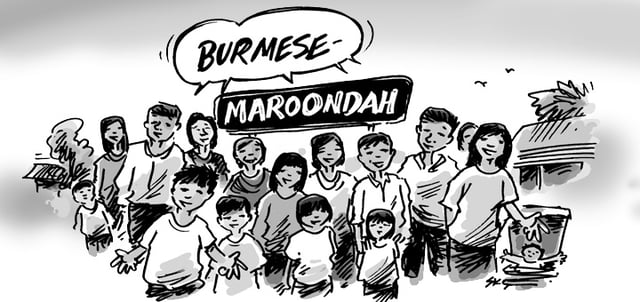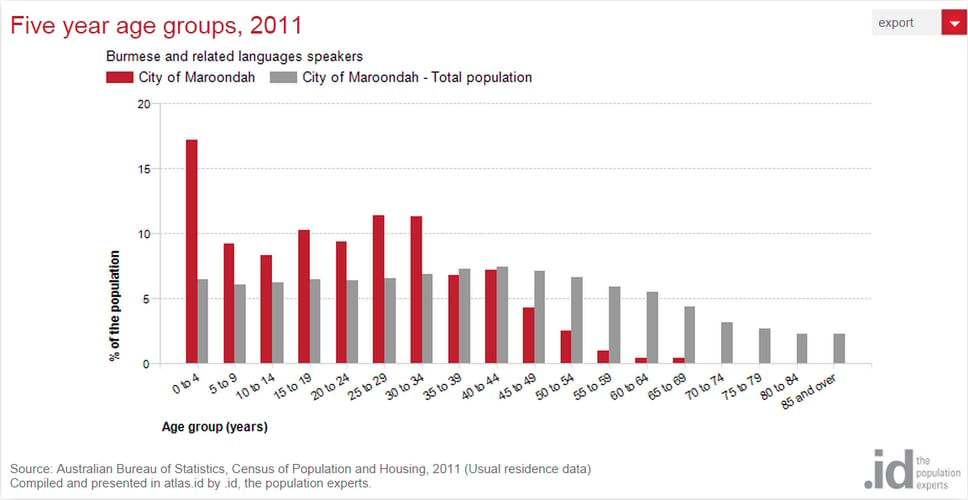.id’s new Communities of Interest modules can give a fascinating insight into the characteristics of particular groups in the population. They are particularly interesting when used to study recent emerging communities from different cultural backgrounds, and how they are integrating into local society. The City of Maroondah is home to a small but rapidly increasing number of refugees from Burma (Myanmar). Here is how profile.id Communities of Interest tells their story.

Maroondah sits between 22 and 30km from Melbourne in the outer eastern suburbs. It is not well known as a culturally diverse area, and has relatively low rates of Non-English speaking background population, when compared to other parts of the eastern suburbs, such as Dandenong, Monash and Whitehorse. Nevertheless, the 2011 Census shows an increase from 9.1% to 12.6% of population speaking a language other than English at home. This is still less than half the Melbourne average, but over 4,000 of the 4,600 increase in population over 5 years was made up of the NESB population.
While much of this is comprised of Chinese and Indian migrants moving outward in the metropolitan area from places such as Glen Waverley and Box Hill, Maroondah does have one community which is rather unique to the area. Since 2006 the council has been actively involved in resettling refugees from the military regime in Burma, and from refugee camps in Thailand, fleeing persecution in their home country.
Maroondah wished to understand this community better, and requested this group be included in their Communities of Interest module. Because there are quite a few children born in Australia, and in Thailand, of Burmese origin, it was decided to use language (not birthplace) as the indicator for the community, which includes all Burmese languages – including Burmese, Karen, Chin and other languages spoken in the country.
In 2011, Maroondah had 1,105 Burmese speakers, a community which had grown from practically none (70 people) in 2006.
Burmese speakers in Maroondah are very young – both compared to the total population of Maroondah, and Burmese speakers elsewhere. In 2011, 17.2% were aged under 5, with the other peak being among their parents, aged between 20 and 34.

This is reflected in the household structure, with a whopping 91.5% of Burmese speakers in couple families with children. Whole families are being resettled in Maroondah.
These are large households as well – no less than 51% of Burmese speakers are in households with 6 or more persons, compared to just 6.4% of total population. As you would expect from a very recently arrived group, over 90% are renting – but in the private market, not social housing, which in Maroondah is mainly occupied by the elderly and single parent families. But those large households are not in particularly large dwellings, with a dominance of 2-3 bedroom homes for the population. This is part of a general trend towards families occupying smaller (and particularly high density) dwellings while couples and empty nesters occupy larger dwellings. But that’s for another blog.
The Burmese community are very well connected in Maroondah, with 87% having broadband internet at home, higher than the total population. But most households have access to only one vehicle, rather the 2-3 which is the norm in the area. If you look at the map of the Burmese community, however, you can see that they are mainly in the parts of Maroondah which are well served by public transport, around Ringwood East and Croydon stations in particular, so access to transport may not be such a problem.
English proficiency is an issue for this population, as with many recent migrants – 66.6% had poor or no English proficiency, and the ABS had special translation services in place to assist with the count of this group. A lot of effort is put into getting accurate counts of new migrant groups each Census.
This leads to relatively poor employment outcomes, with an unemployment rate of 21% and participation rate in the labour force of only 41%. It is likely these will improve as the community becomes more settled in the area over time. But these figures are important to know for a Local Government Area providing key support services for new migrant groups.
You can find all this information about the Burmese community in Maroondah, and more, under the “Communities of Interest” heading on the Maroondah profile.id site.
Does your area have a unique population group you’d like to know more about? This kind of detail is now available for Communities of Interest defined by Birthplace, Language, Income, Age, Disability, or Year of Arrival, and can be added to any profile.id site. Learn more and register your interest here.











